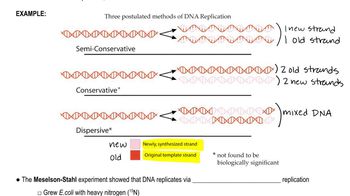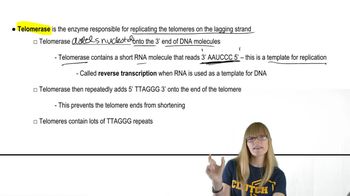It has been shown that infectious agents such as viruses often exert a dramatic effect on their host cell's genome architecture. In many cases, viruses induce methylation of host DNA sequences in order to enhance their infectivity. What specific host gene functions would you consider as strong candidates for such methylation by infecting viruses?
Table of contents
- 1. Introduction to Genetics51m
- 2. Mendel's Laws of Inheritance3h 37m
- 3. Extensions to Mendelian Inheritance2h 41m
- 4. Genetic Mapping and Linkage2h 28m
- 5. Genetics of Bacteria and Viruses1h 21m
- 6. Chromosomal Variation1h 48m
- 7. DNA and Chromosome Structure56m
- 8. DNA Replication1h 10m
- 9. Mitosis and Meiosis1h 34m
- 10. Transcription1h 0m
- 11. Translation58m
- 12. Gene Regulation in Prokaryotes1h 19m
- 13. Gene Regulation in Eukaryotes44m
- 14. Genetic Control of Development44m
- 15. Genomes and Genomics1h 50m
- 16. Transposable Elements47m
- 17. Mutation, Repair, and Recombination1h 6m
- 18. Molecular Genetic Tools19m
- 19. Cancer Genetics29m
- 20. Quantitative Genetics1h 26m
- 21. Population Genetics50m
- 22. Evolutionary Genetics29m
17. Mutation, Repair, and Recombination
DNA Repair
Problem 22
Textbook Question
Describe the 'end-replication problem' in eukaryotes. How is it resolved?
 Verified step by step guidance
Verified step by step guidance1
Understand the 'end-replication problem': In eukaryotic cells, DNA replication occurs in a semi-conservative manner, where the DNA polymerase enzyme synthesizes new strands. However, DNA polymerase cannot fully replicate the ends of linear chromosomes (telomeres) because it requires a primer to initiate synthesis and cannot fill in the gap left after the removal of the RNA primer at the 5' end of the lagging strand.
Recognize the consequences of the problem: Due to the inability to replicate the very ends of chromosomes, telomeres progressively shorten with each cell division. This shortening can lead to loss of essential genetic information and cellular aging (senescence).
Learn how eukaryotic cells resolve the problem: Eukaryotic cells use an enzyme called telomerase to counteract telomere shortening. Telomerase is a ribonucleoprotein that contains an RNA template complementary to the telomeric DNA sequence. It extends the 3' end of the chromosome by adding repetitive nucleotide sequences.
Understand the mechanism of telomerase action: Telomerase binds to the overhanging 3' end of the telomere and uses its RNA template to synthesize additional telomeric repeats. This extension provides a template for the lagging strand synthesis, ensuring that the chromosome ends are fully replicated.
Explore the biological significance: Telomerase activity is high in germ cells, stem cells, and certain cancer cells, allowing them to maintain telomere length and divide indefinitely. In contrast, most somatic cells have low telomerase activity, leading to gradual telomere shortening and limited cell division capacity.
 Verified video answer for a similar problem:
Verified video answer for a similar problem:This video solution was recommended by our tutors as helpful for the problem above
Video duration:
1mPlay a video:
Was this helpful?
Key Concepts
Here are the essential concepts you must grasp in order to answer the question correctly.
End-Replication Problem
The end-replication problem refers to the difficulty eukaryotic cells face in fully replicating their linear chromosomes during cell division. DNA polymerase, the enzyme responsible for DNA synthesis, cannot completely replicate the ends of linear DNA molecules due to its inability to initiate synthesis without a primer. This results in the progressive shortening of chromosomes with each cell division, which can lead to genomic instability.
Recommended video:
Guided course

Semiconservative Replication
Telomeres
Telomeres are repetitive nucleotide sequences located at the ends of eukaryotic chromosomes that protect them from degradation and prevent the loss of essential genetic information during DNA replication. They act as a buffer zone, ensuring that the coding regions of the DNA are not affected by the end-replication problem. Over time, telomeres shorten with each cell division, which is associated with aging and cellular senescence.
Recommended video:
Guided course

Telomeres and Telomerase
Telomerase
Telomerase is an enzyme that adds repetitive nucleotide sequences to the ends of telomeres, counteracting the end-replication problem. It is composed of a protein component and an RNA template that guides the addition of telomeric repeats. Telomerase is active in certain cell types, such as stem cells and germ cells, allowing them to maintain telomere length and continue dividing, which is crucial for tissue regeneration and development.
Recommended video:
Guided course

Telomeres and Telomerase
Related Videos
Related Practice
Textbook Question
509
views


